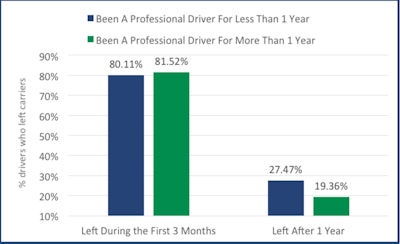 One finding in the new research shows a higher early turnover rate for drivers with more than one year of industry experience.
One finding in the new research shows a higher early turnover rate for drivers with more than one year of industry experience.Stay Metrics, a provider of driver feedback, engagement, training, and retention solutions for the transportation industry, shared new research on the causes of early driver turnover.
Stay Metrics has worked with more than 100 trucking companies to solve human resource issues and collected data from over 62,000 drivers. Ongoing research by the company shows more than 70 percent of driver turnover occurs within the first year of employment with 35 percent happening in the first three months.
The authors of the new report, led by Timothy Judge, Ph.D., Chief Science Officer of Stay Metrics, reviewed an academic model of early turnover by drawing from research literature. The academic model is compared with empirical data obtained from Stay Metrics’ suite of Driver Survey products and driver turnover data provided by its clients.
The academic model shows that employee dissatisfaction with jobs triggers an intent to quit within the first four months. Stay Metrics data reflect more aggressive emergence of dissatisfaction and turnover intent, resulting in a pattern of early turnover in the trucking industry.
The new research examines the impact of driver demographic characteristics, industry tenure, attitudes and work experiences, among other factors, that influence early turnover.
Key findings are summarized below:
- Age differences among drivers are insignificant for early leavers. Millennial drivers are no more likely to leave during the first year than Baby Boomers.
- Experienced drivers (1+ year of industry tenure) have higher early-stage turnover. Once drivers stay longer than 1 year with a carrier they are more likely to remain compared to those with less experience.
- Early-stage leavers have a surprisingly more positive attitude toward their employers than drivers who leave after one year. Judge noted this “honeymoon effect” of job change is consistent with academic research in other industries.
- Driver attitudes towards recruiters and dispatchers are a strong signal of early stage turnover. Drivers with high recruiter satisfaction have a 22 percent lower turnover rate in the first three months compared to those with low satisfaction. Likewise, high dispatcher satisfaction is associated with 16 percent lower early turnover.
Stay Metrics administers surveys for motor carriers to assess driver attitudes shortly after hire and a longer annual attitude survey. The research data used in this latest report comes from its 7-Day and 45-Day Orientation Surveys and in-depth Annual Driver Survey.
“We are pleased to continue offering the latest scientific research to help motor carriers fine-tune their strategies to retain more of their best drivers,” said Tim Hindes, Chief Executive Officer of Stay Metrics. “The most recent report highlights the value of recruiting with driver retention in mind and using survey data at critical periods of the employment lifecycle to reduce driver turnover.”
To obtain a free copy of the new report, “Is Early Turnover Damaging the Business? How and What Can We Do to Stop It?” visit http://staymetrics.com.











